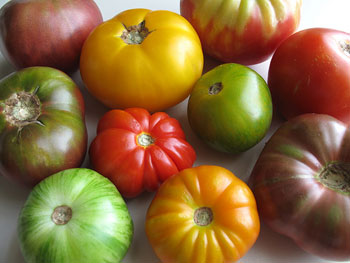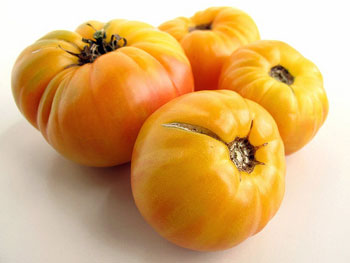 I think just about everyone loves tomatoes. Every time I mention to someone that I grow tomatoes in my garden they immediately turn a little green with envy. Tomatoes are really a labor of love. Some years the bounty is great and in others you're lucky to pick just a few. Last year there was the blight and this summer it's blossom end rot due to the extreme variations in heat. Luckily my tomatoes haven't been affected by that but since I am growing them organically, I do often find a critter who has made a home inside one of my prized possessions. I guess that just shows I'm not the only one who loves them.
I think just about everyone loves tomatoes. Every time I mention to someone that I grow tomatoes in my garden they immediately turn a little green with envy. Tomatoes are really a labor of love. Some years the bounty is great and in others you're lucky to pick just a few. Last year there was the blight and this summer it's blossom end rot due to the extreme variations in heat. Luckily my tomatoes haven't been affected by that but since I am growing them organically, I do often find a critter who has made a home inside one of my prized possessions. I guess that just shows I'm not the only one who loves them.
This year I'm growing heirlooms for the first time. I collected seeds from my favorite specimens last year to grow this crop. All plants were babied from seed. They all seem to be doing well, but heirlooms have their own peculiarities including odd shapes, split skins, and areas with russeting or blemishes. Nut I would rather tend to them than grow the supermarket hybrids, which tend to look more like plastic. Though I do like a beefsteak tomato now and then. I don't even bother growing plum tomatoes because I can't get them any better than the canned San Marzano variety from Italy, where the weather and terroir is optimal for growing them. But so far my soil has given me a pretty nice colorful collection.
I cannot imagine summer without tomatoes. The juiciness, sweetness, and acidity all culminate in one delicious vegetable or fruit? Botanists define fruit as ovaries bearing the seeds of flowering plants. So, yes, tomatoes are fruits. That's even if we almost always enjoy them in savory applications, they are after all sweet and juicy, much more like a fruit than say a turnip? By U.S. law though, they are considered vegetables due to a decision to impose a duty on vegetables in 1893 when the Supreme Court decided to include tomatoes in that tariff. So tomatoes are officially vegetables in this country. Maybe that's why the USDA considers ketchup a vegetable along with French fries for balanced school lunches.
 In Europe tomatoes are considered fruits. And they have been a pretty popular fruit since the 16th century when they first showed up on ships coming back from the Americas. Tomatoes originally came from the New World, specifically South America. Corn, peppers, and potatoes also originated from the Americas. These vegetables made it to the Old World as a result of Spanish exploration. At first many thought tomatoes were poisonous, which is what they thought of the entire nightshade family, which tomatoes and eggplant belong to. It took a while for them to be eaten and enjoyed in cooking.
In Europe tomatoes are considered fruits. And they have been a pretty popular fruit since the 16th century when they first showed up on ships coming back from the Americas. Tomatoes originally came from the New World, specifically South America. Corn, peppers, and potatoes also originated from the Americas. These vegetables made it to the Old World as a result of Spanish exploration. At first many thought tomatoes were poisonous, which is what they thought of the entire nightshade family, which tomatoes and eggplant belong to. It took a while for them to be eaten and enjoyed in cooking.
Tomatoes were already being enjoyed in Spain, but in France it took some clever marketing to make them sell. A clever marketing guru originally coined tomatoes pommes d'amour or apples of love, claiming that the fruit was an aphrodisiac. I guess so. After all they're mostly blood red and juicy. A fruit to excite deep-seated lust and passion? Eventually tomatoes spread to Italy and sauce was born. But can you imagine if tomatoes didn't make it to the Old World? What we would do without tomato sauce? Our pizzas and pastas would be vastly different.
So thank goodness for tomatoes. Our world cuisines would never be so good without them. And our summers could never be so enjoyable without juicy tomatoes freshly picked from the vine. That is all I need to enjoy them. Or if I'm in the mood a little salt and olive oil drizzled on some thinly sliced red fruit.
Heirloom Tomato Salad
2 pounds heirloom tomatoes of various kinds
coarse sea salt
freshly ground black pepper
extra-virgin olive oil
red-wine vinegar
handful basil leaves
Core tomatoes and cut 1/4-inch thick slices.
On a large platter, lay tomato slices overlapping. Season each slice with salt and pepper. Drizzle with about 3 to 4 tablespoons of olive oil and of vinegar.
Gather basil leaves together and roll into a cigar shape. Slice crosswise into very thin ribbons. Sprinkle over tomatoes. Serve salad immediately. Yield: 4 servings.
Joseph Erdos is a New York–based writer and editor, but above all a gastronomer and oenophile. He shares his passion for food on his blog, Gastronomer's Guide , which features unique recipes and restaurant reviews among many other musings on the all-encompassing topic of food.

